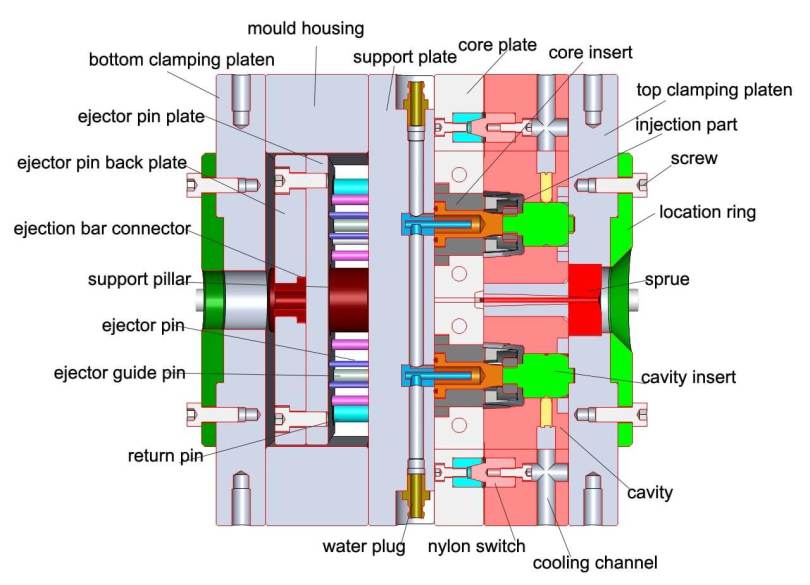Strategic procurement for Injection Molding and Tooling
On the one hand, through understanding the injection molding and tooling supplier's production capacity and market conditions, the company helps the company to strategically introduce competition into the supply system to reduce procurement costs

on the other hand, it can effectively control its demand by helping the injection molding and tooling company to better understand the internal demand model.
Strategic procurement includes the following important principles:
Consider the total cost
the total cost is not a single purchase price, but includes the entire process from injection molding and tooling pricing to material delivery, storage, use, conversion to the corresponding product, until the product is accepted or complained by the customer. The sum of expenditures;
Turning negotiations into commercial negotiations
Negotiation with suppliers is not a negotiation between rivals, but a process of business negotiation, based on a full understanding of the market and in line with the long-term communication of the company's own long-term planning.
Total injection molding and tooling cost analysis, supplier evaluation, and market assessment provide factual and data information for this process, helping companies to understand their bargaining powers and thus master the entire negotiation process and initiative;
Establish a partnership based on a win-win situation
the win-win concept is rarely used in procurement. Most people like us to be knives and others are fish; but the win-win concept is an indispensable factor in strategic procurement.
A stable partnership must adhere to the principle of win-win
Cooperation based on checks and balances
There is a process of mutual comparison and mutual selection between enterprises and suppliers. If there is sufficient understanding of the industry, supplier's business strategy, operation mode and competitive advantage of the supplier, It can help companies find opportunities and find a balance in win-win cooperation.
Strategic procurement implementation
Centralized procurement
Through the concentration of procurement to improve bargaining power and reduce unit procurement costs; many group-developed enterprises usually have their own branches in procurement, which greatly affects the purchasing advantages and can be adopted through the platform. Resolve and other methods to solve;
Expanding the supplier base
Introducing more competition by expanding supplier selection can help enterprises find the optimal resources, ensure the maximum utilization of resources, and reduce procurement costs;
Optimize the procurement process
To achieve strategic procurement, develop a reasonable process, and use the process as a basis for procurement and a tool for process control;
Unified products and services
In the initial stage of procurement, we will fully consider the operating costs of future storage and transportation, maintenance, consumables replenishment, product replacement and other aspects, and strive to improve the uniformity of products and services and reduce the follow-up costs brought about by differences. .
I have been doing procurement for a few years, and dare to ask "strategic procurement" how much?
From traditional procurement to strategic procurement is the development trend
So what are the characteristics of strategic procurement that are different from traditional procurement? To sum up, there are the following main points:
1. Determining the changes in the focus of the supplier: Traditional procurement basically only pays attention to the purchase unit price, and often ignores the influence of other factors such as quality and inventory on the procurement cost; strategic procurement pays more attention to the total cost of procurement, and regards the unit price as the total. Part of the cost;
2. Changes in the number of suppliers: Since traditional procurement pays more attention to the purchase unit price, it often adopts multiple bidding methods to determine suppliers, so the number of suppliers is large; strategic procurement emphasizes highly centralized procurement, and the number of suppliers is reduced or even single; Note that a single supplier here refers to the company's interaction with multiple suppliers, choose one of the best suppliers, establish a long-term cooperative relationship, and implement highly centralized procurement, which will help reduce risks and costs. Improve quality and service levels;
3. Changes in relationship with suppliers: The conversion of traditional procurement suppliers is very frequent. The transactions between enterprises and most suppliers are short-term, simple trading relationships; strategic procurement regards suppliers as partners and is committed to long-term cooperation;
4. Changes in the role of the procurement department: Traditional procurement is regarded as transactional work, procurement is only passively implementing the requirements put forward by the demand department; strategic procurement emphasizes the professionalism of procurement, and requires procurement to participate actively, or early participation, early participation In the confirmation of daily business needs, the early involvement of the broad sense also included the early involvement of suppliers.
Comments
Post a Comment